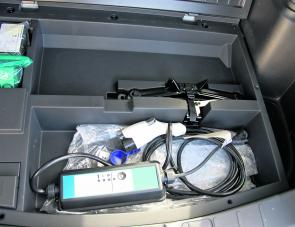Claiming a world first, Mitsubishi has released its 2014 Outlander PHEV as the first plug-in hybrid SUV. Smart marketing has seen the new Outlander PHEV introduced to a market that’s clamouring for SUVs yet with the added bonus of electric power to minimise fossil fuel usage. It’s a great concept and has the potential to make the Outlander PHEV ideal for a lot of families living and working in the city.
For the record, PHEV (pronounced as the letters of P-H-E-V rather than the word ‘fev’) stands for Plug in Hybrid Electric Vehicle.
There’s not much to distinguish this hybrid from the conventional petrol or diesel powered models, aside from a chrome grille, 18” wheels and appropriate badges. PHEV variants include a standard model plus a top-shelf Aspire. The standard PHEV is like the regular Outlander LS with cloth trim, dual zone air, 7” multimedia screen with sat nav and reversing camera, Bluetooth phone and audio, proximity key plus auto headlights and wipers. There’s also hill hold assist, active stability control and seven air bags.
The Aspire has leather trim, heated front seats, a power driver’s seat, power sunroof and tail gate, adaptive cruise control and a WiFi based smartphone app that controls a host of the vehicle’s functions.
The PHEVs have a towing capacity of 1500kg for a braked trailer (500kg less than the Outlander diesel models and 100kg less than standard petrol units). Unbraked trailers are limited to 750kg.
The Standard model reviewed featured an interior virtually identical to other Outlander models thanks to a decent blend of soft and hard surfaces across the dash area, and an eye-pleasing trim. However, the PHEV’s main gauges were supplemented by a monitor for the battery system and distribution of electrical power. Likewise, the multimedia screen also offered a lot of information including power usage and total driving range available. The usual features such as electric windows and cruise control were naturally standard. Rear seat room was typical Outlander – plenty for three adults.
The PHEV’s main propulsion is via twin front and rear 60kW output electric motors. Working continuously, they are linked to a four cylinder 2.0L petrol engine which has both charging and motive power duties. When batteries need charging or the driver demands hard acceleration, the petrol engine will be humming quietly up front.
Pure electric output sees a range of 52km with absolutely minimal fossil fuel usage, hence Mitsubishi’s claim for a staggering 1.9L per 100km. However, this will only be achievable when driven in electric mode and not exceeding that 52km range. On an extended highway run of 600km where the petrol engine was also sharing the load, I averaged 7.8L per 100km which, although not class leading, was still very good by many modern SUV’s standard.
The Outlander relies on the two electric engines for main motive force with gear boxes providing direct drive through a series of automated clutches. Trust me, it’s no slouch off the mark.
There are three distinct automatically selected drive modes. With EV mode selected there’s ample power to cruise at 110hm/h. ‘Series’ mode kicks in when batteries are in need of a charge and the petrol engine does its stuff to rejuvenate them. When there’s extended cruising at highway speeds or maximum power required, the petrol engine is involved (‘Parallel’ mode) to drive the front wheels with the electric motors still assisting.
All round performance is very good. The electric motors have ample power and with both the electric and petrol engines working together the Outlander feels very similar, power wise, to the vehicle’s previous 2.6L petrol V6.
Driving the Outlander PHEV is as easy as driving any other auto wagon. There’s a joystick-style gear selector, two pedals and a steering wheel with interesting paddles. You can easily monitor power usage via the display gauge system or via the battery symbol within the main dash.
The PHEV can be charged on the move by using the steering column’s left side paddles to bring in regenerative charging via the braking system. It’s similar to changing down gears, with retardation felt when braking or coasting.
There’s also a console operated ‘Charge’ button which kicks in the petrol engine to charge the battery when the vehicle is either on the move or when stationary if a dedicated power point is not handy.
At-home charging of the PHEV’s under floor 12kW/h lithium ion battery pack is via the supplied charging cable. It takes up to five hours.
Both PHEV variants feature AWD on demand – activated by a switch on the centre console – via an advanced torque vectoring system which effectively splits drive equally front to rear for optimum traction. In either electric or petrol assist mode, the system works very well. I gave the PHEV some work on rough fire trails in purely electric mode and found it certainly didn’t lag in power. The brilliant torque vectoring AWD set-up made wheel slip a near impossibility and gives the Outlander serious credentials as an off-road capable SUV. It’s pretty eerie traversing ruts and washouts with only a hum from the electric engine and its sophisticated transmission to break the silence!
The PHEV was a delight to drive and I merely kept an eye on the battery state indicator on the dash and activated the petrol engine when power was getting low. The car won’t stop if the battery is depleted of course; the petrol engine simply takes over to drive the front wheels while topping up the battery system. The run up the Tollbar Range to Toowoomba saw the gearing getting a work out and the petrol engine working pretty hard, but once on the Darling Downs the run to Dalby saw both engines taking it easy.
For families that rarely travel long distances, the new Outlander PHEV is hard to beat. True, the technology comes at a price ($47,490 for the standard model reviewed). However, seeing as there are tremendous fuel savings to be had for the driver who takes full advantage of the electric power system, the owner would soon be smiling, even while the car was still within its 5-year warranty period.
Reads: 2767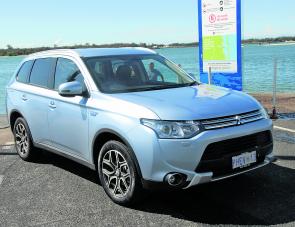
The Outlander PHEV’s AWD on demand system sees the vehicle very capable around boat ramps.
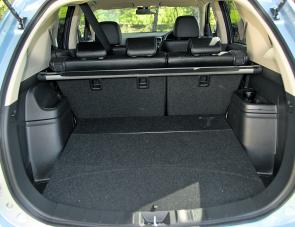
A large rear cargo area remains a big selling point with the hybrid Outlander. Note the cargo blind up top.
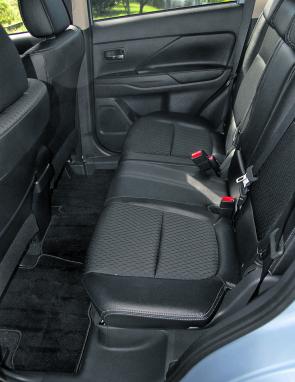
The Outlander’s generous rear seat room remains unchallenged.
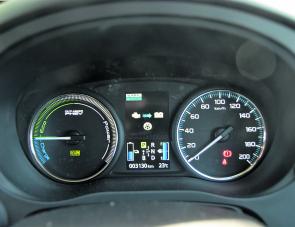
Easily monitored dash gauges keep the driver informed as to the battery’s status. Here I have activated the petrol motor to charge the battery.
